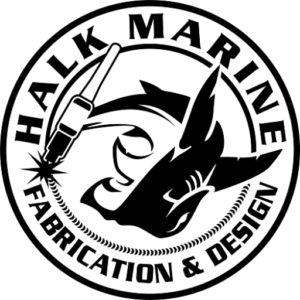Bare Aluminum

There’s a reason most military and commercial aluminum boats are not painted!
Marine aluminum alloys possess 3 great characteristics for marine and boat fabrication compared to steel and other materials: high strength to weight ratio, excellent corrosion resistance, and ease of fabrication and forming.
While steel, including stainless, will rust if it’s uncoated, aluminum remains relatively corrosion free when it’s exposed to saltwater and oxygen. This is because it naturally forms a protective layer of aluminum oxide on its surface which protects it from further oxidation. This thin layer forms almost instantaneously so it’s self healing. This means nearly zero maintenance is required save for preventing stray electrical currents or dissimilar metal contact.
The only drawback to leaving aluminum bare is the appearance. Bare aluminum will become dull gray over time, with a gritty texture from the oxide film. Observe commercial and military aluminum vessels: they are almost never painted and they last for decades!
Painted Aluminum
If the aesthetic appearance of your boat or top is important, then paint and other coatings become an options. You also may need to paint the hull bottom if you’re keeping in the slip long term to prevent fouling organisms from growing under the waterline. Paint is more economical and practical on very large surfaces such as the hull, decks, and top sides.
Preparation of the surface is especially critical when painting aluminum. Remember, the oxide layer reforms instantaneously so you have a very short window to start priming and painting after preparation so that you form a strong molecular bond between the metal and the coating.
The steps for properly painting aluminum are as follows:
- Mechanical preparation (sanding or blasting) to provide the correct surface texture for paint to adhere.
- Chemical preparation by acid washing. This clears the oxide coating ahead of paint.
- After rinsing and drying, immediate follow up with primer coating. The rule of thumb is within 4 hours, and the sooner the better!
- Once primed, carry on with the painting process to the desired level of finish.
To read more about the details of properly painting aluminum and pitfalls to avoid, I recommend this excellent article by Steve D’Antonio, a well known marine consultant and surveyor.
Powder Coating
 Powder coating is performed by spraying dry polymer resin powder onto a metallic surface which is electrically charged. By electrically charging the metal object, the powder is electrostatically pulled to all exposed surfaces. The coating is then baked in a large oven at 300-400 degrees to melt and cure all the ingredients and form a hard shell.
Powder coating is performed by spraying dry polymer resin powder onto a metallic surface which is electrically charged. By electrically charging the metal object, the powder is electrostatically pulled to all exposed surfaces. The coating is then baked in a large oven at 300-400 degrees to melt and cure all the ingredients and form a hard shell.
Powder coating is more durable and damage resistant than paint, and it comes in thousands of colors and finishes. The main limitations are the size of part and cost.
Here’s a breakdown of my experience with the cost of powder coating items.
- Small brackets and accessories – $10-$50 each
- Casting and poling platforms – $150-$300
- T-top and other large structures – $800-$2000.
Anodized Aluminum

Brushed finish anodized pipe.
Anodizing is an electrochemical process which coats the surface of the aluminum with a hard, thin oxide coating to preserve the finish of the underlying metal. The process is basically a controlled, high speed version of the natural oxidation process. By electrically charging and dipping the aluminum in an acid solution, the protective oxide layer forms uniformly on the entire surface.
Anodized aluminum pipe is usually sold as polished or brushed finish. This finish is applied first, then the pipes or machined items are anodized. A polished or brushed anodized pipe will maintain this appearance for many years without much maintenance other than rinsing.
Anodized pipe can be welded, but it is more challenging than typical aluminum TIG welding. Why? The extremely thin aluminum oxide layer that forms the anodize coating melts at 3700°F while the underlying aluminum melts around 1200°F. This behavior leaves black/grey particles of oxide in the weld puddle, which makes it more challenging to produce a visually pleasing weld. The oxide layer is also not electrically conductive, so the fabricator must be careful where he places his grounding cable to avoid hideous arc strike marks.



Share this entry